|
|
|||
Parent Empowerment Circle
|
|
|||
Parent Empowerment Circle

June is National Homeownership Month! Homeownership plays a vital role in our economy and can help build individual wealth, promote community stability, and improve overall health. But like any investment, a home requires regular maintenance to keep it in good shape.
As we enter the summer months, here are a few maintenance tips to keep your home in top condition:
Indoor Maintenance Tips:
Outdoor Maintenance Tips:
By addressing maintenance issues early, you can help prevent costly repairs down the road.
For a more detailed list, visit the National Center for Healthy Housing website for a spring and fall maintenance checklist and click on Healthy Homes Maintenance Checklist.
This article was written by Rodney Denholm, Chisholm Trail District Agent. If you found this article useful, take a moment and provide feedback at https://bit.ly/49SMXra. For more information contact Tara Solomon-Smith, [email protected], 620-244-3826.
# # #
Kansas State University Agricultural Experiment Station and Cooperative Extension Service
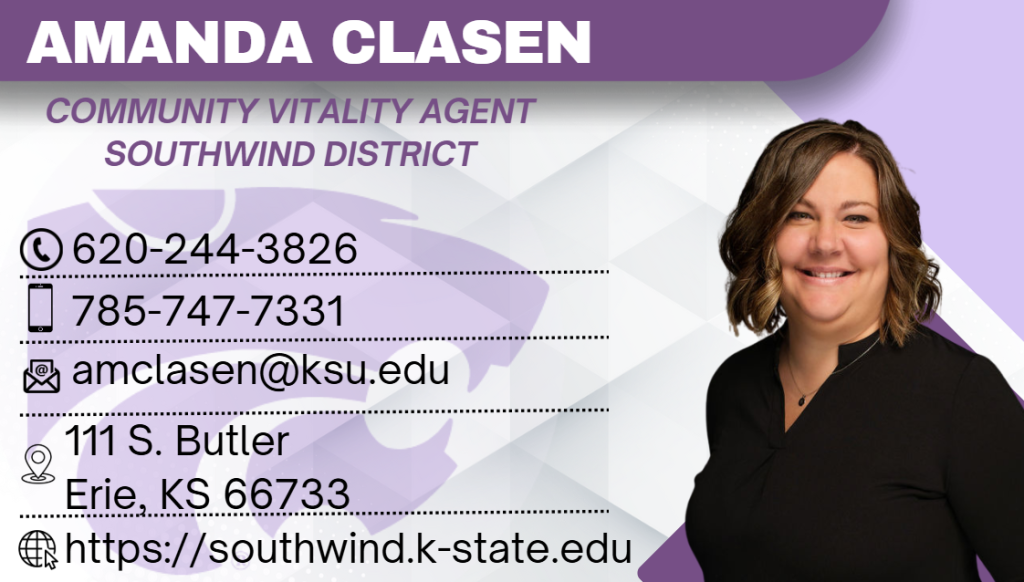
As the days grow longer and the sun warms our sidewalks, there’s a familiar buzz in the air: summer is here, and with it comes opportunity.
It’s more than just a season—it’s a moment when our community shines its brightest. The farmers’ market hums with local produce. Sidewalk cafes fill with neighbors and newcomers alike. Downtown shops welcome foot traffic that brings stories, laughter, and support.
Summer tourism may feel like a visitor’s game, but it’s actually a community team effort. Every family that stops at the splash pad, every couple who books a B&B or grabs ice cream on Main Street—they’re more than tourists. They’re economic partners. When we support and promote local attractions, events, and businesses, we strengthen the very heartbeat of our town.
Whether you’ve lived here for decades or just moved in, you’re part of the hospitality that makes this place unforgettable. It starts with simple things:
Behind every storefront is a family, a dream, and often a neighbor. And in many cases, summer makes the difference between making it and closing up shop.
It’s easy to overlook the hidden gems in our own backyard. When someone asks for local events or places to visit, we often draw a blank—not because they aren’t there, but because we’ve grown so used to them. Need a reminder? Here are 5 simple ways to support locals this summer:
This summer, let’s not just welcome visitors—let’s also rediscover the charm of our own backyard. Your support matters. Your presence matters. And together, we can ensure this season brings prosperity not just for a few weekends—but for the year ahead.
For more information, please contact Community Vitality Agent Amanda Clasen at any Southwind District office.

Bagworms are a yearly pest in our area and can cause considerable damage. Most homeowners typically don’t get too concerned about bagworm control until they see large bags present on plants. By then it is too late and the damage is already done! The window of opportunity for optimum control is approaching.
Bagworms overwinter as eggs deposited in the female bags. From mid-May through mid-June, larvae hatch from the eggs and exit from the bottom opening of the old bag. Larvae begin constructing their miniature silk-lined bags immediately. Only after the bags have been completed do the larvae begin actual feeding activities. And as the larvae grow, so do their bags. By mid-to late August when feeding activities are complete, larvae firmly anchor their bags to the twigs and branches on which they were feeding.
Bagworms are most commonly found on eastern red cedar and junipers. However, bagworms can attack arborvitae, spruce and pine. Broadleaf trees, shrubs and ornamentals can also serve as a host to bagworms. After bagworms have defoliated a host plant, they are capable of migrating in search of additional food sources. They may attack the same species from which they came or a completely different species.
The damage caused by bagworm feeding can be minimal to severe. As larvae enter their later development stages, they require greater amounts of food. Sometimes in what seems to be just overnight, bagworms can completely defoliate a tree. Several successive years of heavy foliar feeding can result in the death a tree, especially with conifers.
There are two ways to control bagworms – cultural and chemical. Cultural practice is used by those who do not want to utilize insecticidal sprays to control bagworms. Instead, bagworms are eliminated by handpicking individual bags from plants. This is best done in the winter months when bags stand out against a trees background color. Keep in mind that a single missed bag could result in a thousand new bagworm larvae. Of course, handpicking becomes impractical when a host is literally covered with bags or it is too tall to make handpicking possible.
Chemical control is most effective when larvae are in their early developmental stages. Generally, bagworm larvae will begin emerging from the overwintering bag by mid-to late May. Hatching does not happen overnight. Instead, hatching can continue for 4 to 5 weeks. Controls applied in late summer are often a waste of time and expense because the larvae are large, tough and may have stopped feeding. About the third week of June is the ideal time to make insecticidal control.
Insecticides commonly used to control bagworms include spinosad, acephate, cyfluthrin, or permethrin. These are sold under a variety of trade names. Check the product label for active ingredients.
For more information on bagworm control, please contact me at one of our Southwind Extension District office locations.
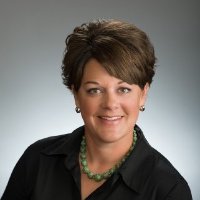
Krista Harding is a K-State Research and Extension Horticulture agent assigned to Southwind District. She may be reached at [email protected] or 620-244-3826.
K-State Research and Extension is an equal opportunity provider and employer.

Sandy Haggard is the new Southwind K-State Nutrition, Food Safety, and Health Agent, who has an office out of Iola.
Haggard has been employed in the current Kansas State University Research and Extension, Southwind District since April 14
She felt this job was a good fit.
“I’ve often had a position where I coordinated a program or gave presentations, so I was looking for a position where I could use those skills. Also, at Neosho County Community College, I had been working in the same four counties with older adults who volunteered at non-profits, so I’m able to keep in touch with several of the same contacts. I had attended several K-State Research and Extension programs during the eight years I’ve lived in Kansas, so I was excited to work alongside the agents I’ve known for years. I’m looking forward to giving presentations on nutrition and health and getting to know more people in our four-county area.”
The job is multi-faceted.
Her duties include leading the development, implementation, and evaluation of research-based educational programming related to nutrition, food safety, and health.
This includes nutrition through the life cycle, supplemental nutrition education, food security, consumer and food handler food safety, local food systems, physical activity promotion, and chronic disease prevention.
She will be covering four counties: Allen, Bourbon, Neosho, and Woodson.
In the next year, she hopes to have programs for ServSafe food handling, Dining with Diabetes, Food Preservation, and Basic Nutrition, she said.
She earned her Bachelor’s Degree in Elementary Education and Secondary English from Northwest Missouri State University, Maryville, MO, and Adult Education from Prescott College, Prescott, Arizona.
Haggard taught Adult Basic Education/GED Instruction at Northland Pioneer College, Winslow, Arizona.
She taught internationally as a Middle School English teacher at Morrison Academy in Kaohsiung, Taiwan, and was a part of the English Faculty at Meiho University, Neipu, Taiwan.
Most recently, she has been the RSVP Director with AmeriCorps Seniors at Neosho County Community College (NCCC) serving Allen, Bourbon, Neosho, and Woodson Counties.
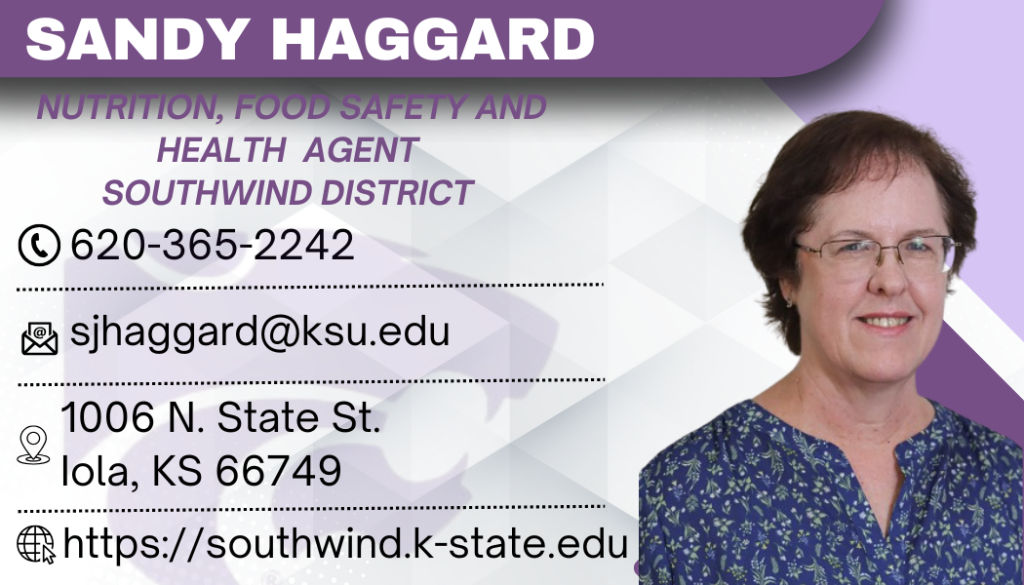 |
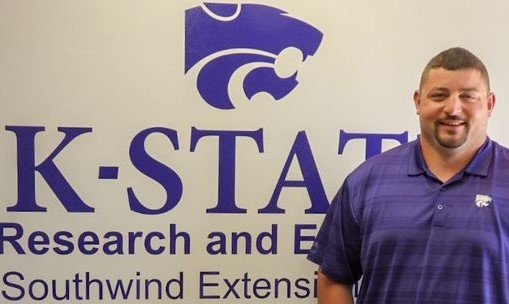
Soybean planting is well underway in Kansas with 43% planted, based on the USDA-NASS Crop Progress and Condition Report from May 19, 2024. However, heavy rainfall has occurred in many locations across the eastern half of Kansas, with some fields underwater and others with completely saturated soil. If you have been fortunate to get some early soybeans planted here are things to remember.
Wet soil conditions will slow emergence, make the soil more susceptible to compaction (limiting root growth), and cause poor plant-to-plant uniformity after emergence.
Sidewall compaction occurs when soybeans are planted when the soil is too wet, immediately followed by dry weather.
Soil surface crusting is another potential challenge for soybean emergence.
If soybean plants are submerged for less than 48 hours, there is a good chance they will survive. Plants can survive underwater longer in cool temperatures than in warm temperatures. Submerged soybean plants can survive for up to 7 days when temperatures are less than 80 degrees F.
To determine whether the soybeans are damaged after the water recedes, split the stem at the tip and examine the growing point. A healthy growing point will be firm and white or cream-colored. A soft, dark growing point indicates injury. In some cases, the silt coating the plant after short-term flooding can cause more injury than the water itself, possibly even plant death.
Even if the fields do not have standing water, and plants are not totally submerged, waterlogged soils can cause problems if the waterlogging lasts too long.
When soils are saturated for a prolonged period, a lack of oxygen in the roots can lead to the accumulation of lactic acid and other products of anaerobic respiration. This is the underlying cause of damage to plants in waterlogged soils where only the roots are flooded.
Injury can depend on variety, growth stage, duration of waterlogging, soil texture, fertility levels, and diseases present.
Interactions of these factors make it hard to predict how a given soybean field will react to waterlogged soils. Variety differences have been reported, and researchers have identified possible genes associated with tolerance to waterlogged conditions.
Scientists in Missouri have screened a number of soybean varieties, subjecting them to two periods of flooding, each two weeks in duration. The average yield reduction for all varieties was 61%. Yields were reduced by 39% for the most tolerant varieties and 77% for the least tolerant. Producers should check with their seed supplier regarding information about a particular variety.
As always if you are noticing issues in your fields feel free to contact me through your local K-State Extension Office to set up a consultation and field visit to asses and try and alleviate the problem.
If needed, I will work with you to send photos of the problem (close-up, seedling, field shot) and plant samples to the K-State Plant Disease Diagnostic Lab.
Lonnie Mengarelli is a K-State Research and Extension Agriculture agent assigned to Southwind District. He may be reached at [email protected] or 620-223-3720
Tina Sullivan, Northeast Area Agronomist
[email protected]
Rodrigo Onofre, Plant Pathology
[email protected]
Chandler Day, Associate Diagnostician, Plant Pathology
[email protected]

Do you have to clear a spot just to sit down? Always searching for lost items? Tired of being the family’s go-to picker-upper? You’re not alone. Clutter creeps in from every corner of the home—but the good news is, you can take control.
Getting Started
Set aside a few days for big cleanups. In each room, start in one spot and move clockwise. Use boxes to sort items into: Keep, Store, Give Away/Sell, and Throw Away.
Closet Organization Tips
Tips to Maintain a Clutter Free Home
This article was adapted from the fact sheet Cut the Clutter and Get Organized. For more information contact Tara Solomon-Smith, [email protected], 620-244-3826.
# # #
Kansas State University Agricultural Experiment Station and Cooperative Extension Service

The month of May marks Small Business Month, a time dedicated to recognizing the powerful role small businesses play in our communities and our economy. While they may be “small” in size, their impact is anything but.
Across the country, small businesses account for nearly half of all private-sector jobs. They’re run by our neighbors, friends, and family members—the people who know us by name, remember our usual orders, and go the extra mile to serve. But behind every small business is a story of hard work, risk, and perseverance. Entrepreneurs invest time, energy, and resources—not to mention heart—into their dreams. Many wear multiple hats, juggle uncertain finances, and navigate ever-changing market demands. And still, they show up every day to keep their doors open, often with a smile.
This month is an opportunity for all of us to say thank you. We can do that by choosing to shop local, spread the word about our favorite businesses, or even leave a positive review online. These seemingly small actions add up and can make a world of difference.
If you’re a small business owner—or thinking about becoming one—there are excellent local resources available to help you succeed:
Whether you’re launching a new venture or growing an existing one, these resources are here to help—and they’re just a phone call or a click away.
As we celebrate Small Business Month, let’s remember that when we support small, we strengthen all. The success of local businesses is closely tied to the well-being of our communities. Let’s continue to invest in that success—not just in May, but all year long!
For more information, please contact Community Vitality Agent Amanda Clasen at any Southwind District office or [email protected].

If you haven’t jumped on the bandwagon of planting to attract butterflies – you need to! I love watching butterflies flit around my yard. Not only are they enjoyable to watch, but they also serve as pollinators for some plants. Sure, some butterflies will probably always visit your yard from time to time, but if you want to get serious about attracting more to your landscape, you must provide for their basic needs. This includes food, shelter, liquids, and a sunning location.
If you want butterflies to be more than just visitors looking for a good source of nectar, then you have to create a true butterfly habitat. This will encourage more butterflies to call your garden their home! One way to encourage more butterflies to your landscape is by utilizing plants that serve the needs of all stages of the butterfly. This means planting nectar plants and host plants.
Nectar plants are what the adult butterflies feed on. It is the color and shape of these flowers that will attract the butterflies. Plant nectar plants in masses using three or more plants of one variety. In the nectar plant category, there are many annuals and perennials that can be utilized. Some of the must-have annuals include zinnias, lantana, verbena, and French marigold to name just a few. Perennials utilized as a nectar plant include aster, black-eyed Susan, coneflower, milkweed, catmint and bee balm.
Even some shrubs and herbs are great nectar plants for butterflies. Of course, as the name would imply, butterfly bush is a great addition, along with lilac, mock orange, and spirea. Grow herbs for not only culinary purposes but as a nectar and host source. Plant chives, dill, sage, thyme, and fennel.
Host plants are those plants that butterflies lay their eggs on and that caterpillars feed on. Plant these with the expectation that the will be partially eaten by the developing butterfly. For me, I love walking out and looking at the developing caterpillars and I’m happy to share my plants with them! At the top of this plant list, it is milkweed. Milkweed is the exclusive food source for Monarch caterpillars. There are many different types of milkweed, but the butterfly milkweed is one of the more eye-catching. Other host plants that I like to plant include parsley, dill and fennel. These are great host plants for Black Swallowtails.
Butterflies also need protection from the wind and predators. This can be accomplished by incorporating certain trees and shrub species into the landscape. Butterflies use hackberry, elm, ash, willow and pawpaw trees. Host shrubs include spicebush and prickly ash.
You can make your butterflies feel more at home in the landscape if you will add a few light colored stones. Place these in a location protected from the wind. This will become an area where butterflies can bask in the sun and warm themselves. Incorporate a shallow container filled with sand and keep it moist. Butterflies will gather on the damp sand to take up needed salts and minerals. An occasional treat of rotting or overripe fruit will also keep butterflies happy!
Finally, be mindful of pesticide use. Pesticides not only kill undesirable insect pests, but they also kill butterflies and their caterpillars.
Now is the time to get busy creating a butterfly habitat! I have some wonderful resources available at the Extension office that offers a complete listing of plants. These can be found on the home page of our district website: southwind.ksu.edu or you can pick up a copy at any of our office locations.
Krista Harding is a K-State Research and Extension Horticulture agent assigned to Southwind District. She may be reached at [email protected] or 620-244-3826.
K-State Research and Extension is an equal opportunity provider and employer.
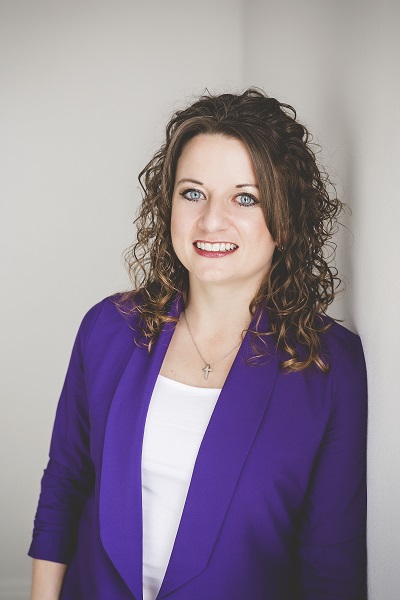
[email protected], 620-244-3826
Did You Know?
Board games can help people learn important soft skills like self-control, confidence, communication, getting along with others, and solving problems. These are the kinds of skills that help us do well at school, at home, at work, and in everyday life.
Soft Skills vs. Hard Skills
There are two kinds of skills we all need: soft skills and hard skills. Both are important, but they help us in different ways.
Soft skills are about how we act and how we treat others. They include being kind, staying calm, listening, working with a team, and solving problems. These skills help us handle change and get along with people everywhere—at school, at home, or at work.
Hard skills are things we learn to do, like using a computer, reading a map, or doing math. These are usually taught in school or through practice. They help us complete tasks and do jobs.
While hard skills can change over time, soft skills always matter. Today, soft skills are not just “nice to have”—they’re something we must have to succeed.
How Board Games Help Kids Learn and Grow
Board games are not just fun—they help kids practice soft skills while playing! Here’s how board games help kids grow:
Working together helps close the job skills gap.
To help people get ready for future jobs, everyone needs to work as a team—businesses, teachers, families, and leaders. Soft skills like teamwork, problem-solving, and communication have become even more important.
Board games are a fun and powerful way to help people learn these skills. When families, schools, and communities use games to teach, they give kids and adults the tools they need to do well in school, at work, and in everyday life.
This article is the final one in a three-part series and comes from information in the Bonding Thru Board Games fact sheets. For more information contact Tara Solomon-Smith, [email protected], 620-244-3826, or visit https://www.southwind.k-state.edu/home-family/family_child_development/
# # #
Kansas State University Agricultural Experiment Station and Cooperative Extension Service

April 20th–26th marks National Volunteer Appreciation Week, a time dedicated to honoring the individuals who give their time and energy to serve others. Like many organizations, Extension programs could not function without the dedication of their volunteers. These individuals are the backbone of countless efforts that make our communities stronger, more connected, and more resilient.
Volunteering is more than just lending a hand—it’s a powerful way to foster community growth and development. When individuals unite around a shared goal, they bring diverse skills, experiences, and passions to the table. This collective action helps address local challenges and build a more inclusive, supportive, and engaged community.
Volunteering doesn’t just benefit the community—it offers meaningful personal rewards as well. Here are just a few of the many benefits:
While the value of volunteering is immense, it’s also important to acknowledge the challenges that come with it:
As spring approaches, many local groups are planning outdoor service projects, and there’s no shortage of opportunities to get involved year-round. Whether you have a few hours a week or a single afternoon to spare, your time can make a lasting impact.
This National Volunteer Week, let’s take a moment to thank those who serve—and consider how we, too, can play a part. Volunteering doesn’t just change the community. It changes lives—including your own.
For more information or ideas on how you can volunteer in your community, contact Community Vitality Agent Amanda Clasen at any Southwind District office or [email protected].

Tara Solomon-Smith
Family and Community Wellness Agent, Southwind Extension District
[email protected], 620-244-3826
Board Games and Strong Families
In today’s busy world, family time can easily get lost in the hustle and bustle of daily life. But spending quality time together is important for keeping family bonds strong. One great way to bring families closer is by playing board games—especially Euro-style games. These games focus on strategy, not luck, and avoid direct conflict between players, making them a fun and positive way to build stronger relationships.
How Do Board Games Benefit Relationship Building?
People need to feel loved and like they belong. Friends and family help with that. Playing board games is a fun way for families and friends to spend time together, laugh, and feel close.
To get along with others, we need to learn things like how to understand our feelings, make good choices, and be kind. These are called soft skills. If kids don’t know how to play nicely, they might act out to show how they feel. But when kids have good relationships, they feel happy and safe.
Talking and listening are very important in families. Good communication helps families solve problems and understand each other. We show we care by really listening, smiling, and using kind voices and body language.
In his book, titled “Family Treasures: Creating Strong Families,” Dr. John DeFrain examines what he says are the six major qualities that strong, successful families exhibit across all cultures in order to create positive environments. These include: enjoyable time together, appreciation and affection for one another, positive communication, spiritual well-being (values, beliefs, and life skills), successful management of stress and crisis, and commitment to each other.
There are ways that families can achieve these six qualities through everyday living.
Enjoyable Time Together
Appreciation and Affection
Positive Communication
Spiritual Well-Being
Successful Stress and Crisis Management
Commitment to Each Other
Board games are a fun way for families to talk, listen, and enjoy time together. When families have fun and talk well, they become stronger and closer.
This article is the second in a three-part series and comes from information in the Bonding Thru Board Games fact sheets. For more information contact Tara Solomon-Smith, [email protected], 620-244-3826, or visit https://www.southwind.k-state.edu/home-family/family_child_development/
# # #
Kansas State University Agricultural Experiment Station and Cooperative Extension Service